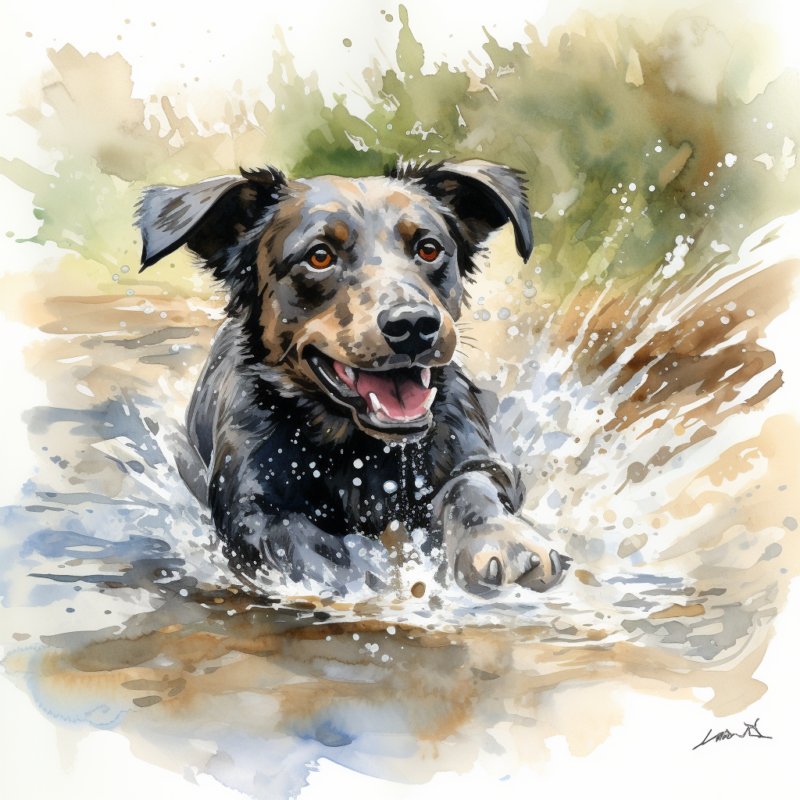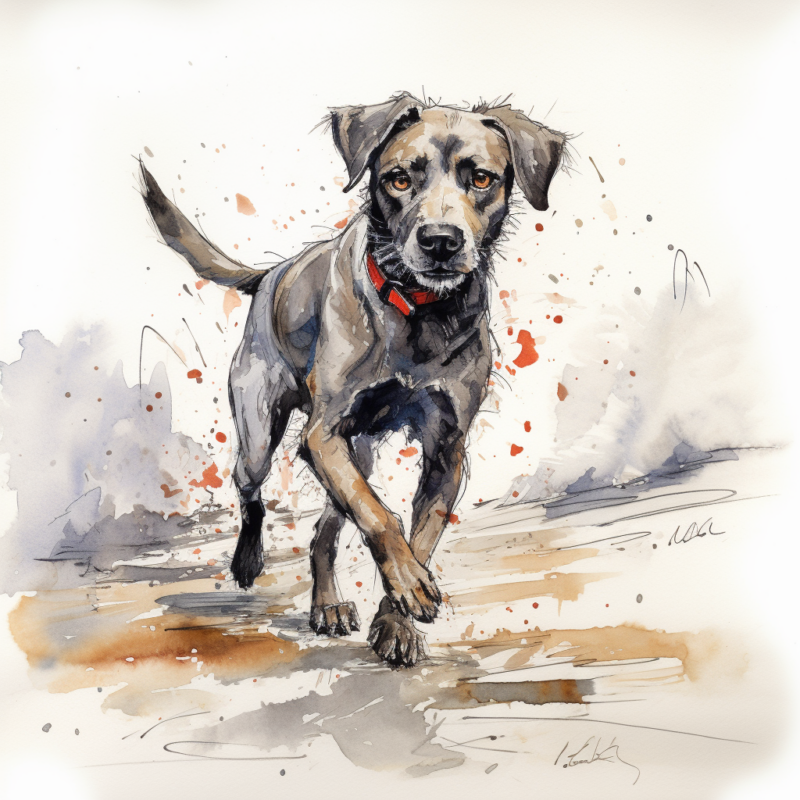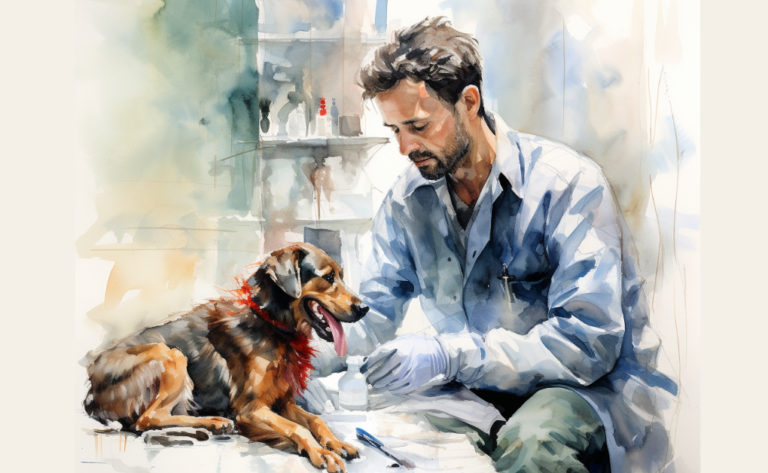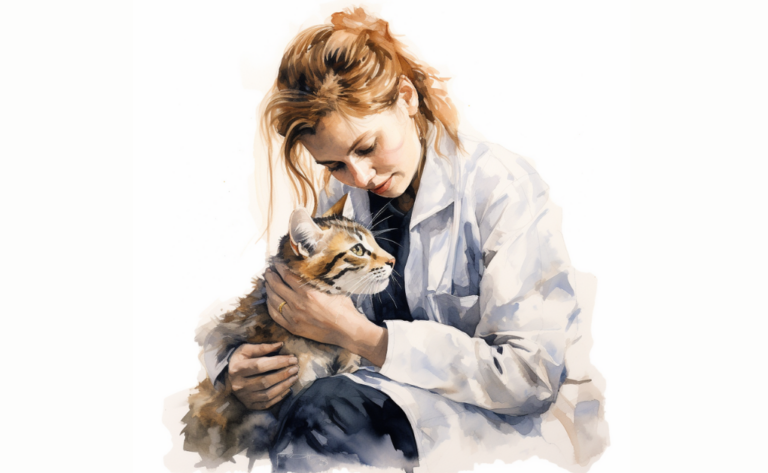What is Leptospirosis in Dogs?
What is it?
How is it Treated?
Breed Predispositions
There are no specific dog breeds that are known to be predisposed to leptospirosis. All dog breeds are equally susceptible to the disease, and the risk of infection depends on the dog’s exposure to contaminated environments, water sources, or infected animals.
One day, a pet owner named Emily noticed that her beloved Australian Cattle Dog, Blue, was showing signs of lethargy, loss of appetite, and vomiting. After taking Blue to the veterinarian, it was discovered that he had leptospirosis, a bacterial infection caused by the Leptospira bacteria that can affect multiple organ systems in the body and can lead to severe illness or death if left untreated.
Leptospirosis is an infectious disease in canines caused by various serovars of the Leptospira genus, a spiral-shaped bacteria called spirochetes. This bacterial infection is a zoonotic disease that can be transmitted between animals and humans. Leptospirosis affects dogs, other mammals, and even humans, causing various symptoms and varying degrees of severity, thus making it a public health concern.
Dogs can contract leptospirosis infection through direct contact with infected animals, ingesting contaminated water, or exposure to a contaminated environment. The bacteria, leptospires, can enter the body through the skin (especially wounds or abrasions), mucous membranes, or the consumption of infected tissues. The bacteria called Leptospira thrive in warm, moist environments, and stagnant water sources such as puddles or ponds can serve as breeding grounds for these bacteria, increasing the risk of kidney disease and other health issues in affected animals.
What are the Causes of Leptospirosis in Dogs
Dogs can contract leptospirosis through several routes of exposure:
- Direct contact with infected animals: Dogs can become infected by coming into contact with infected animals, such as rodents, opossums, livestock, wild animals, or other dogs. They may be exposed to infected urine or tissues. The Leptospira bacteria can enter the dog’s body through mucous membranes, skin (especially if cuts or scrapes), or by consuming infected tissues.
- Ingestion of contaminated water: Dogs can become infected if they drink from or swim in contaminated water sources, such as ponds, puddles, or streams containing the Leptospira bacteria. The bacteria can enter the dog’s body through ingestion or contact with mucous membranes.

- Exposure to contaminated environments: Dogs can become infected by contacting soil, vegetation, or other surfaces contaminated with infected animals’ urine, such as in dog parks. The bacteria can enter the dog’s body through the skin or mucous membranes.
- Bite wounds or consumption of infected carcasses: Dogs may become infected through bite wounds from infected animals or by consuming the carcass of an infected animal, such as farm animals.
Leptospirosis is a zoonotic disease caused by Leptospira bacteria, and it can be transmitted between animals and humans. Leptospirosis can cause a variety of health issues in both dogs and humans. Therefore, it is essential to follow proper hygiene and sanitation practices and ensure that dogs receive appropriate vaccinations to help reduce the risk of infection and protect against the disease when they come into contact with infected animals.

Symptoms of Leptospirosis in Dogs
Canine leptospirosis has a variety of clinical signs in dogs, ranging from mild flu-like symptoms to severe signs of illness. Early common clinical signs of leptospirosis may include:
- fever
- joint pain
- decreased appetite
- reluctance to move
As the infection progresses, more severe leptospirosis symptoms, such as:
- vomiting
- diarrhea
- lethargy
- jaundice (yellowing of the skin or eyes)
- seizures
- kidney failure may be seen
Sometimes, these signs of leptospirosis can become life-threatening if not addressed quickly and appropriately. Since leptospirosis is a zoonotic disease that can be transmitted from animals to people, it’s essential to be vigilant when multiple dogs are showing signs of illness, as catching leptospirosis early is crucial for effective treatment and emergency care.
Diagnosis of Canine Leptospirosis
Diagnosing leptospirosis in dogs requires assessing clinical signs, obtaining a thorough patient history, and performing laboratory tests to detect the presence of the Leptospira bacteria or the body’s immune response. Leptospirosis outbreaks are more common in younger animals, and timely diagnosis of leptospirosis is crucial for effective treatment.
- Blood culture: In the early stages of the infection, veterinarians may attempt to isolate the Leptospira bacteria from the dog’s blood. This method can be time-consuming, yet the success rate could be much higher.
- Polymerase chain reaction (PCR) test: PCR testing is a molecular technique that detects the presence of the Leptospira bacteria’s genetic material in the dog’s blood or urine. This test can provide rapid and accurate results, but false negatives may occur if the dog has received antibiotics before testing.
- Serology: The most common serologic test for diagnosing leptospirosis is the microscopic agglutination test (MAT), which detects antibodies against the Leptospira bacteria in the dog’s blood. A rising antibody titer over time suggests an active infection. However, a single positive test result may not be definitive for diagnosis, as it could also indicate previous exposure or vaccination.
- Complete blood count (CBC) and blood chemistry profile: Veterinarians may perform these tests to assess the dog’s overall health and detect abnormalities associated with leptospiroses, such as anemia, low platelet count, elevated liver enzymes, or impaired kidney function.
Diagnosing and treating dog leptospirosis promptly is crucial, as dogs that survive the infection may still suffer long-term health complications.
Treatment Options for Leptospirosis in Dogs
Veterinarians treat leptospirosis in dogs using a combination of antibiotic therapy and supportive care. The goal is to eliminate the bacteria, manage the symptoms, and help the dog’s body recover from the infection. Here is an overview of the treatment approach:
- Antibiotics: The primary treatment for leptospirosis is antibiotics, which effectively kill bacteria. The most commonly prescribed antibiotics for leptospirosis are penicillin (ampicillin or amoxicillin) and doxycycline. Treatment typically lasts 2-4 weeks, depending on the severity of the infection and the dog’s response to the therapy.
- Supportive care: In addition to antibiotics, dogs with leptospirosis often require supportive care to manage their symptoms and help their bodies recover from the infection. Supportive care may include:
- Intravenous (IV) fluids: Dogs with severe dehydration, vomiting, or diarrhea may need intravenous fluid therapy to help maintain hydration and electrolyte balance.
- Nutritional support: Dogs with reduced appetite or difficulty eating may need nutritional support, such as a special diet or feeding tube feeding.
- Anti-nausea medications: To control vomiting and nausea, veterinarians may prescribe maropitant or ondansetron.
- Kidney and liver support: In cases where leptospirosis has caused kidney or liver damage, dogs may need additional medications and treatments to support organ function.
- Pain management: Pain-relieving medications may be prescribed to alleviate discomfort associated with the infection.
- Oxygen therapy: If the dog is experiencing difficulty breathing, oxygen therapy may be administered to support respiratory function.
It is essential to follow your veterinarian’s treatment plan and recommendations closely, as early and appropriate intervention can significantly improve your dog’s chances of recovery. Additionally, maintain proper hygiene and sanitation practices to minimize the risk of spreading the infection to other animals or humans. Widespread vaccination can help protect infected dogs and improve public health in internal medicine.
How to Prevent Leptospirosis in Dogs
- Vaccination: One of the most effective ways to prevent leptospirosis is to vaccinate your dog against the disease. A vaccine that protects against the most common serovars of Leptospira bacteria that cause infection in dogs is available. Speak with your veterinarian, who specializes in veterinary internal medicine, about whether the leptospirosis vaccine is appropriate for your dog, as the disease risk can vary depending on your location and your dog’s lifestyle.
- Control rodent populations: Since rodents and farm animal species are common sources of Leptospira bacteria, controlling their population around your home can help reduce the risk of infection. Seal up potential entry points into your house, store pet food and human food in sealed containers, and use rodent traps if necessary.
- Avoid stagnant water sources: Stagnant water sources such as puddles or ponds can be breeding grounds for Leptospira bacteria. Prevent your dog from drinking or swimming in these water sources, and always provide clean, fresh water.
- Keep your dog on a leash: When walking your dog in areas where there is a higher risk of exposure to contaminated water, soil, or other surfaces, keep your dog on a leash to prevent them from coming into contact with potential sources of infection and direct contact with urine from infected animals.
- Clean and disinfect: Regularly clean and disinfect your dog’s living area, food and water bowls, and toys to minimize the risk of infection.
- Educate yourself: Learn about leptospirosis’ risk factors and prevalence in your area. If you live in a region where the disease is more common or your dog frequently engages in activities that increase its risk of exposure, it is essential to take extra precautions.
By following these preventive measures and consulting with your veterinarian about your dog’s specific risk factors and vaccination needs, you can significantly reduce your dog’s risk of contracting the disease and developing liver or kidney complications.
Frequently Asked Questions
Disclaimer: The information provided on this veterinary website is intended for general educational purposes only and should not be considered as a substitute for professional veterinary advice, diagnosis, or treatment. Always consult a licensed veterinarian for any concerns or questions regarding the health and well-being of your pet. This website does not claim to cover every possible situation or provide exhaustive knowledge on the subjects presented. The owners and contributors of this website are not responsible for any harm or loss that may result from the use or misuse of the information provided herein.







